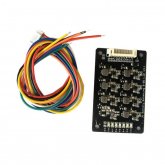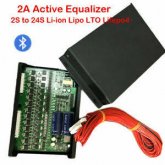Were you building the diyBMS from boards purchased from the online store that has the SMD parts pre-populated? That would help a bit. Also noticed he is working on an updated version of the controller:
https://community.openenergymonitor.org/t/diybms-announcements/15515/4
I'm building them via order of JLCPCB.
Sadly seldom the Attiny 841 on stock, so that need to be soldered.
Order via openenergymonitor will give you the PCB, Attiny and contact pins to solder.
After this.. still programming.
At 3* the price of JLCPCB.
At my first order there was no thermistor in-stock so I order both via Digikey.
0403 thermistor is not funny to solder. If I would have known, I would have waited or choose different part that have the same specifications. (Learning curve)
Even with microscope just to damn small to do.
During my order of the controler board I was new to Reddit and the whole Gerber / BOM file world..
Ended up soldering all parts by hand

SMD 0805 is not that bad to do.
Once you have all software setup and plugins, it's not too difficult to follow the steps is the videos.
Before you figure out what plug-in is needed.....
(I placed it in the comments section of the tutorial videos)
After soldering 12 of the 20 where functional...
Just too damn small parts that take me weeks to solder.
I do have energy disorder, tasks like those, really costs me.
(Nerve damage after surgery, 15 years ago, been on high dose tramadol/ morphine /oxicodon ever since, after 5 years or so I learned to live with the side effects of tramadol, pain is tolerable, but does eat loads of energy. While I can do "everything" I need to choose.
Do I build one or two BMS board or do groceries.. for that day.
Trying to do 3 will set me back a few days, being able to do about nothing except recharge.
The specialist at the hospital calls me a success story.. as I still am active and do things.
It's strange to teach my 80 year ord father with hart problem how to deal with less energy..
That's a step aside...
Back to topic, most people won't even try to go solder an SMD that they can hardly see without optical help...
Or install several programs on their laptops to program/flash a chip / IC.
I'm trying to figure out what is the reliable BMS today that can give the required feedback of SOC and cell voltage, preferably web based to avoid the probleem of the need to be within 10 meters to check the battery status.
More and more people are going to get Powerwall at their house.
As it's cheaper then ever.
And many electricity companies pay less and less for excess solar power..
They have too much of it.
Besides that, Thailand..... A stable grid is something you won't find here.
Not even in Bangkok.
Brownout/ blackout are regular.
Lower pricing, better stability.
We are living in a golden period for this development.
Perhaps I'm too focused on BMS.
So many post about trouble....
It seems that there aren't much stable options that have all build in.
(Daly, active balancer BMS)
External, Chargery, Batrium, Electrodamus, ....
They seem to be working as they should.
Somehow people around here think I know a lot about solar

Even drive +7 hours to look at my not yet finished setup...
(And was happy he took the trip!)
Where giving some electricity is easy, a few panels, PWM/MPPT, inverter and LA or small LiFePO4, it's a total different story when you build to power a home or small resort.
10-20-40 kw...
That emerging market does need stable products.





